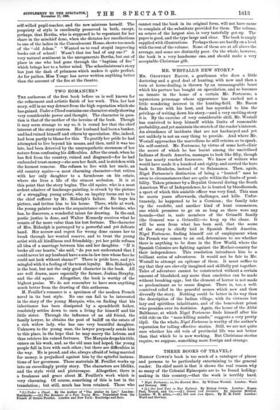TWO ROMANCES.*
Tan authoress of the first book before us is well known for the refinement and artistic finish of her work. This, her last story, will in no way detract from the high reputation which she has gained. Under a Cloud contains one character-study showing very considerable power and thought. The character in ques- tion is that of the mother of the heroine of the book. Though it may seem strange to say so, it is round her that the chief interest of the story centres. Her husband had been a banker, and had ruined himself and others by speculation. She, indeed, had been partly to blame for this. To gratify her pride he had attempted to live beyond his means, and then, until it was too late, had been deterred by the unsympathetic sternness of her nature from confessing his difficulties. After the crash, when he has fled from the country, ruined and disgraced—for he had embezzled trust-money—she sees her fault, and is stricken with the keenest remorse. She refuses to live with her uncle, an old country squire—a most charming character—but retires with her only daughter to a farmhouse on his estate, where she lives a life of the utmost seclusion. It is at this point that the story begins. The old squire, who is a most ardent admirer of landscape-painting, is struck by the picture of a struggling young artist, who on inquiry turns out to be the chief sufferer by Mr. Rideolph's failure. He buys his picture, and invites him to his house. There, while at work, the young painter makes the acquaintance of the heroine, who has, he discovers, a wonderful talent for drawing. In the end, poetic justice is done, and Walter Kennedy receives what he counts of far more value than his lost fortune. The character of Mrs. Rideolph is portrayed by a powerful and yet delicate hand. Her sorrow and regret for wrong done causes her to break through her wonted reserve, and to treat the young artist with all kindliness and friendship; yet her pride refuses all idea of a marriage between him and her daughter. "If it broke all our hearts," she said, "do you not understand that I could never let my husband have a son-in-law into whose face he could not look without shame?" There is pride here, and yet mingled with it a feeling of the truest loyalty. Mrs. Rideolph's is the best, but not the only good character in the book. All are well drawn, more especially the farmer, Joshua Strayby, and the old squire. Altogether, the book is worthy of the highest praise. We do not remember to have seen anything much better from the drawing of this authoress.
M. Feuillet's romance is a specimen of the modern French novel in its best style. No one can fail to be interested in the story of the young Marquis, who, on finding that his inheritance has been dissipated by a spendthrift father, resolutely settles down to earn a living for himself and his little sister. Through the influence of an old friend, the family lawyer, he obtains the post of bailiff on the estate of a rich widow lady, who has one very beautiful daughter. Unknown to the young man, the lawyer purposely sends him to this place, in the hope that he may marry the heiress, and thus retrieve his ruined fortunes. The Marquis drops his title, enters on his work, and, as the old man had hoped, the young people fall in love with each other; but there are difficulties in the way. He is proud, and she, always afraid of being married for money, is prejudiced against him by the spiteful insinua- tions of her governess. These materials M. Feuillet works up into an exceedingly pretty story. The characters are lifelike, and the style vivid and picturesque. Altogether, there is a freshness and grace about M. Feuillet's work which is very charming. Of course, something of this is lost in the translation ; but still, much has been retained. Those who
• (1.) Tinder a Cloud. By the Author of "The Atelier du Lys." London : Ratchards.—(2.) The Romance of a Poor Young Man. Translated from the French of Octave Penillet. London and New York : Rontledge and Sons.
cannot read the book in its original form, will not have cause to complain of the substitute provided for them. The volume, an octavo of the largest size, is very tastefully got-up. The paper is good, and the type large and clear. The book is amply supplied with illustrations. Perhaps these are hardly on a level with the rest of the volume. None of them are at all above the average, and some are distinctly poor. On the whole, however, the book is a very handsome one, and should make a very acceptable Christmas gift.


















































 Previous page
Previous page